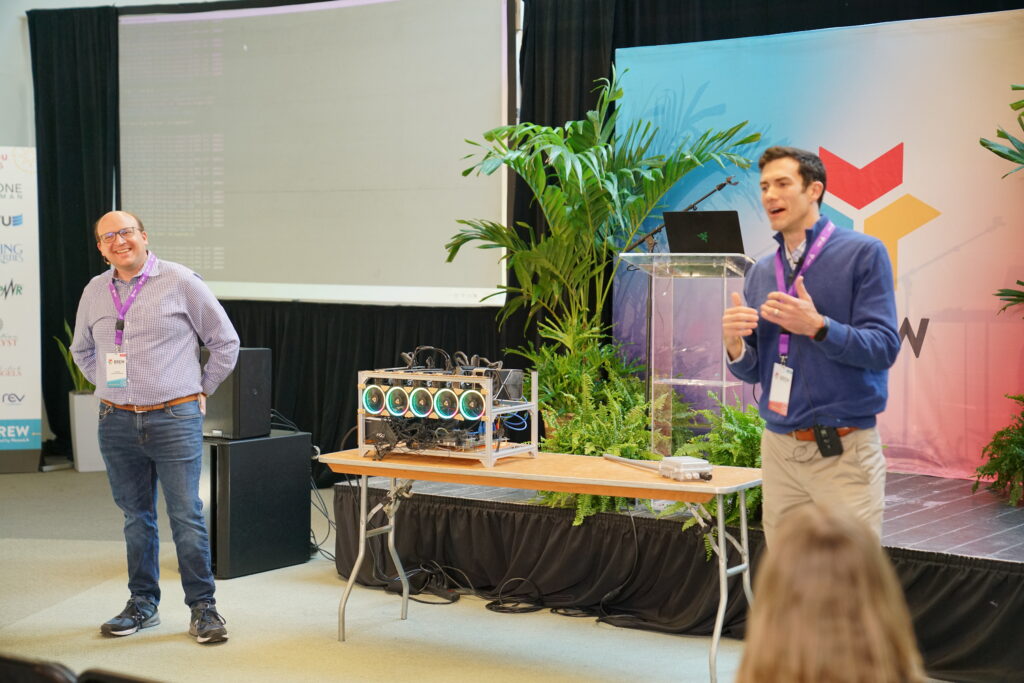It’s been more than a decade since Bitcoin was launched, but the buzz around cryptocurrency remains strong as new coins and applications for blockchain technology continue to be developed. Beyond crypto’s use as an alternative payment method, people have many opportunities to get involved. We might think of crypto and the blockchain that supports it as a seemingly endless stream of indecipherable code drifting into the ethers of a digital realm, but it takes a robust array of hardware to secure it and fuel its growth.
At BREW 11, Craig Gehring, founder and CEO of MasteryPrep, and Jared Loftus, co-founder of MasteryPrep and founder and CEO of the crypto mining company MaxBoring, gave us some insight into the hardware demands for crypto and how those are shaped by goals and different types of coins.
Proof of Work
The decentralized element of most cryptocurrencies appeals to many, and the lack of a central authority to keep tabs on their usage and trade has created challenges and opportunities. Cryptocurrencies rely on a consensus mechanism to build trust and security into a decentralized computer network. Because there is no central figure with the ability to record, edit and update transactions, public blockchains share a ledger that provides real-time data on all the transactions taking place. The integrity of the blockchain relies on the efforts of thousands of machines worldwide that verify and authenticate blockchain transactions and block-mining activities. This is achieved by using a consensus mechanism — a set of rules that determines the legitimacy of blockchain contributions made by the various participants.
Several such mechanisms exist and are used to support different coins, and they also have different hardware and data requirements. Proof of work is a common algorithm used to arrive at blockchain consensus. Bitcoin and other cryptocurrency networks use it. Under this model, a participant device must prove that the computations it has done and submitted qualifies it to be eligible to add new transactions to the blockchain. This type of mining requires high amounts of energy consumption and a longer processing time, so fast machines with multiple graphics cards running computations are typically used.
Proof of Stake
With ongoing activity, a blockchain becomes longer and requires more processing. This means that keeping up with the processing demands of proof of work mining can require increasing amounts of investment in computing muscle. Alternatively, proof of stake, another common consensus mechanism, has been positioned as a lower-cost alternative to the proof of work algorithm that also uses less energy. In this system, the public ledger is maintained in proportion to the number of virtual currency tokens owned.
This contrasts with proof of work, which rewards participants based on the computations performed by machines. So, instead of being rewarded for having an army of powerful computers, proof of stake most heavily rewards those who hold the most tokens. Participants can put those “at stake” with just one powerful machine connected to the network.
The popular cryptocurrency Ethereum, notably, is moving from proof of work to proof of stake.
Proof of Coverage
While the aforementioned models remain the most widely used, they aren’t the only ones available. At BREW, while holding up a device that looked like a fuse box attached to a piece of electrical conduit, Loftus said, “This represents proof of coverage.” Gesturing to a much larger device, illuminated by brightly colored, dancing LED lights, he said, “This represents GPU mining and proof of work.”
He explained that the smaller device supports a proof of coverage blockchain, specifically the one used for Helium transactions. Instead of raw computing power, devices connected to this network are rewarded for extending wireless data coverage that is used to connect internet of things devices. Bringing coverage to new places means earning more crypto.
Industrial applications for this technology bring data to sensors and devices, expanding their usage and making them more cost-effective. These devices require much less power consumption than devices used in proof of work or proof of state, and they instead are reliant on data connections.
“When you hear in the media that all crypto is bad for the environment, that’s simply not true because not all crypto is proof of work. There are plenty of crypto projects that are safe,” Loftus said. For people thinking of investing in new hardware to earn cryptocurrency, there are quite a few options already. It’s likely that the future will bring even more possibilities as new coins are introduced and new consensus mechanisms are developed to support them.




